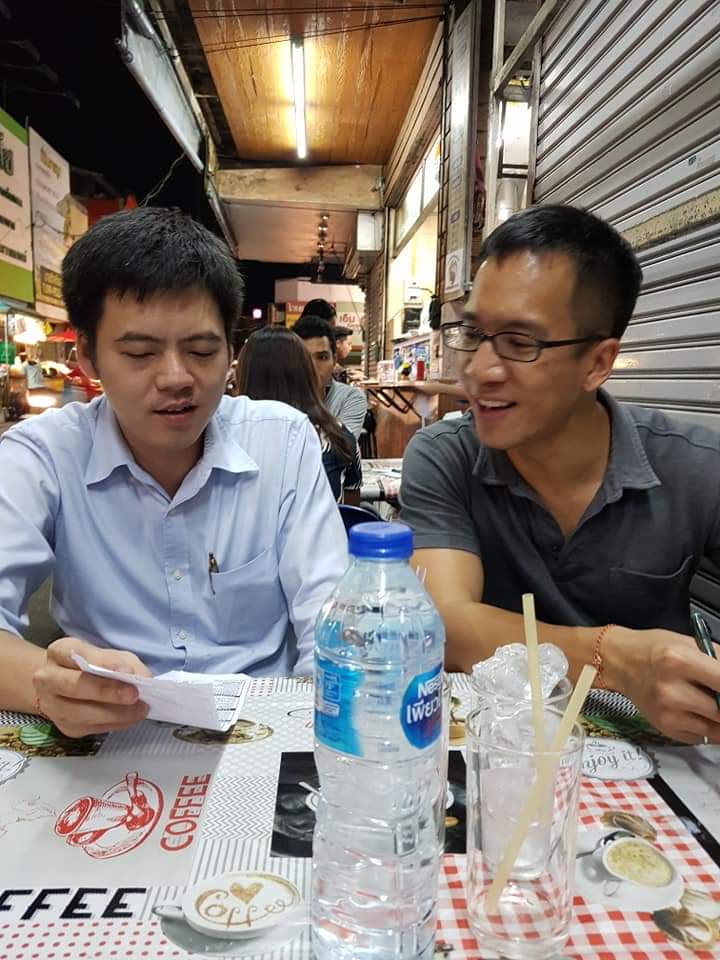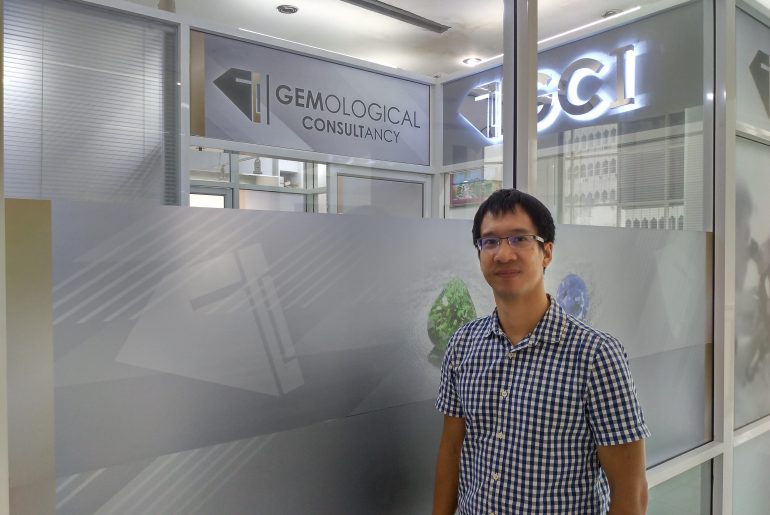
Pattarat Kaeng Termpasit also known as Pat for his near and dear ones is one of the founding members of a gemological lab in Bangkok called Gemological Consultancy International (GCI) Bangkok. He along with his partner Surachart Panjathammawit (see previous interview) were the first ones to offer verbal gem testing services in Bangkok.
He also taught gemology at GIA(Bangkok) and AIGS(Bangkok) and has experience of around 17 years in teaching.
Here we take a look at his journey in the field of gemology.
Q. Hello Pattarat. Welcome to the interview session of littlegemologist. Please tell us something about yourself. When did you start your journey of in gemology?
Ans. Hello Gaganveer. Thank you for having me in your interview session. My carrier in gemology started from my university. I did my bachelor in material science and in those 4 years of bachelor degree i focused on gems and jewellery process.
After my graduation I joined GIA(Bangkok) as an instructor.
Q. How long have you been teaching and how has been your experience till now?
Ans. I taught in GIA for 8 years and after i left GIA(Bangkok) i taught at AIGS(Bangkok) for another 8-9 years.So my carrier is all about teaching.
Q. Did u ever try to become a gem trader?
Ans. Yes, but after some time I found out it was not my cup of tea.
Q. We don’t see many gemological institutes as compared to jewellery designing institutes. What do you think is the reason?
Ans. Opening a gem school is expensive proposition. You need to find good teachers who can teach and know about market trend as well. Schools have their own expenses and need to keep wide variety of gemstone samples as well. Secondly they also need to invest in instruments which are quite expensive.
Q. Do u think 6-7 months are enough to teach gemology ?
Ans. Basic gemology can be easily taught in 6-7 months. But to be an expert gemologist be it in field or in lab requires decades of experience and skills.
Q. There are many treatments in gemstones like high heat, low heat, beryllium diffusion, glass-filling, etc. How easy you think it is to teach students to identify them ?
Ans. In class we don’t expect students to become expert right away. But we teach them general guidelines as to how they should check the quality and characterstics of stones. Of course some gemstones have to be sent to an advanced lab but some treatments like glass-filling can be checked by microscope.
Q. What is the easiest part in teaching gemology ?
Ans. Operating instruments I beleive is the easiest part. Teaching students how to operate and handle refractometer, polariscope,dichroscope is not difficult. It’s important to teach students the right way of using instruments and also their limitations. Once they learn that half the work is done.
Q. As far as instruments are concerned spectroscope is one of the important one but I have rarely seen any student using them or practising with them in the field.
Ans. It’s difficult to recognize all the patterns and memorize them. It also takes considerable amount of time to master spectroscope. Apart from that there are some limitations as well. Eg: – Yellow sapphire and yellow chrysoberyl both have roughly same area of absorption in iron band so here Refractive Index is better measure.
Second is the light source. You need to have proper lightsource to check the spectrum pattern. Seeing the stone in just any light will not give you accurate result always.
Q. How subjective you think is the colour grading in gemstone?
Ans. Highly subjective, I would say. Even in diamond colour grading colour G given by one lab may be given colour grade H by other lab.But that is how this field is.
Q. What you think about the names like muzo green, peacock blue, pigeon blood red instead of vivid red, bright green? Why do lab write these names instead of using simple names?
Ans. These names were not started by labs, instead they were started by trading community after which labs started using them. Secondly, i believe a good gemstones deserves a good price. example- if you have 2 blue sapphires one very light blue and other has very beautiful rich blue colour then the second stone needs a special mention. So i guess it’s ok if they give some top quality stones some fancy names.
Q. Do you think in future, it will be possible only for labs to detect treatments as they are getting more sophisticated and harder to detect?
Ans. Right now we are facing problem with low heat treatment using standard equipment as there may not be any change in internal structure of a stone when viewed under 40x microscope.
Therefor there will always be some treatments for which you have to send the stone to an advanced lab.
Q. In nearly every gemological institute they don’t teach how to identfy rough. Why?
Ans. It’s difficult to calculate Refractive Index of rough stone. So its an instrument thing. Dealers who deal in rough generally focus on one or two type of stones and spend years dealing in them. If you go to Myanmar, how will you separate ruby and spinel if you don’t have well defined crystal shape. Its difficult.
In alluvial deposits i.e. secondary deposit how do you separate ruby and spinel quickly. You cannot do that easily. You have to use polariscope and use it every time.
Q. Do you believe good teacher can be a good trader and vice a versa?
Ans. I have no idea regarding that. But I would that say the pattern or style followed by AIGS(Bangkok) is good as students are exposed to those teachers who deal in gemstones as well,they know the market trend and therefore can guide students.
Q. Do you think dealing in rough at early stage of a person carrier is easy way to loose money?
Ans. Dealing in rough initially is gambling business as you don’t know what you are dealing with. There are many people who sell fake rough as well. So in early stages it is a gamble.
Q. What is the advantage of having gemological education and then starting your carrier vis a vis those who start with no prior experience.?
Ans. It’s always good to have education before you start something. Once you have gemological education you will be in a better position to identify and negotiate with your supplier or can gain customer confidence easily.
Q. You have been running your own gem lab by the name of Gemological Consultancy International(GCI)with your partner Surachart . How did you think of starting a lab?
Ans. In beginning we just started with verbal testing. After that clients started asking for more details, like can you print a certificate, or write some details and that is where me and my partner planned to expand and have a proper lab.
Q. Does it often happen that people come and request you to write natural instead of synthetic on the lab report?
Ans. Yes, they do but we simply deny them.
Q. Gubelin have started the concept of block chain where you can check or trace the entire journey of gemstones from mining to the end customer. What are your thoughts about that?
Ans. I would say they should start with diamonds as diamond companies know from which mines diamonds are coming from. It would be easy to keep record of diamonds as they already have kimberley process in place but as far as coloured stones are concerned I believe it would be difficult.
Q. Your partner Surachart (see previous interview) has decided to enter monkhood for life. You both have been friends and partners for around 2 decades. How big a void it would be for you?
Ans. Well it’s not a loss as it’s part of his personal life. It was decided well in advance that he will be entering monkhood so we made preparations and arrangements accordingly to make sure that lab work is not affected and there are enough people with expertise and required skills here running our lab.
At present we are building a team and we are going to expand as well.
Q. At present how many branches you have and how can people contact you for testing their gemstones?
Ans. We have 2 branches. One on 3rd floor,JTC tower, Silom and other in Chan Gems buliding,2nd floor,Chantaburi. We are available in Bangkok Monday to Saturday, from 10AM-5PM and in Chantaburi on Friday and saturday from 10AM-5PM.
Q. Any advice to future gemology students.
Ans. This branch has huge potential for big gains and losses as well. Initially they should start slow, and carefully choose how to grow their business because if they cannot find a market or clients they won’t be able to sell. So find your market,clients. For eg- whether students want to start jewellery business or gem trading only, in which income group their clients fall etc and then make a plan and move forward.
Q. There are many labs giving fake certificates or giving certificates
Ans Some people think lab is just a business where they need to earn profit. They don’t care about end customer. But I guess traders already know which labs they are. Some countries have very strict regulation like Hong Kong.
I guess in Thailand also there will be some standardization in long run where good labs will come together and make some rules which have to be followed by every lab.
Thank you Pattarat for giving your time to littlegemologist. We wish you all the best for future.






